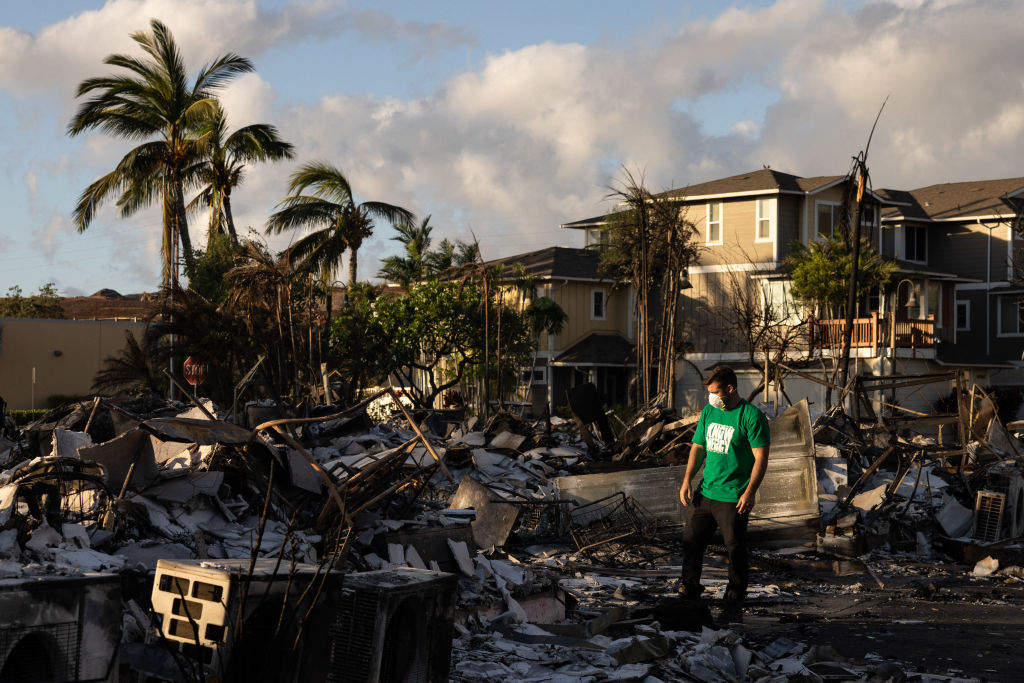After being found responsible for starting a deadly wildfire last summer, Hawaii’s for-profit energy utility is set to receive a public bailout. The episode makes a powerful case for bringing utilities under public ownership.
L | ast August, a deadly wildfire tore through Hawaii, erasing the town of Lahaina and killing over one hundred people. The state’s publicly traded utility corporation was found responsible; it is now facing a deluge of claims from residents seeking compensation for damages, as well as lawsuits from the insurance companies that have been paying out disaster claims.
Hawaii’s electricity is provided by a for-profit utility supplier that is granted monopoly power over energy distribution. In addition to its dominance of Hawaii’s power grid, Hawaiian Electric Industries, Inc., (HEI) enjoys almost complete autonomy in the physical management of its power lines on the islands of Oahu, Hawaii, Maui, Lanai, and Molokai. Only residents of the island of Kauaʻi maintain some semblance of control over their electricity, through a resident-owned energy cooperative.
When massive winds from Hurricane Dora blew into Maui, HEI subsidiary Maui Electric Company (MECO) refused to respond to early calls to shut down the grid. This came even as fire-safety officials warned that a flash drought put most of the state in a Red Flag Warning, the highest possible fire alert issued by the National Weather Service.
More than thirty power lines went down as winds battered the island, but MECO remained silent — apparently refusing to cut power to downed lines that were sparking fires. In the fallout of the fires, it came to light that MECO had not properly insulated wires or maintained poles and surrounding vegetation. These are standard precautionary measures in most states, especially ones with significant wildfire and windstorm risk. Many lines were bare — i.e., lacking any insulation at all — a direct violation of state regulations dating back to 2002 that significantly increased the probability of ignition in surrounding vegetation.
Now, as HEI struggles to pay for damages, state regulators look set to bail out the negligent utility company.
read more: https://jacobin.com/2024/02/maui-fires-corporate-energy-bailout/
HECO sucked enough without this. House let them go bankrupt and break them up, Same with PGE in California after the northern California fires which (checks notes) oh we’re also a result of a utility failing to invest in maintenance on its infrastructure (well, our infrastructure, we paid for it).
It should be a one and done instant takeover by state or the feds when something like this happens.
They also just bailed out of concealed carry guns because they didn’t have the “aloha” spirit. I thought that was especially cool of them.
With regard to a financial bailout, there are really only three options in the end here:
-
Bail them out, let them off the hook, everything goes on as normal.
-
Don’t bail them out, they take the costs out of the utility customers.
-
Don’t bail them out, they do a performative bankruptcy, then are sold and reincorporated in a new name by basically the same people who ran it before.
None of the options end up changing anything.
Instead, the people in charge need to be incarcerated.
It would also be nice if there were some metric for CapEx reinvestment that we could federally mandate for electric utility companies.
We should also mandate that all last-mile lines are covered, to mitigate fire risk. I live in a small SoCal city of 140k people with our own water and electric utility, and we’ve been using covered lines for 30 years. We haven’t had fires caused by our in-town utility in the time that I’ve lived here, which is a lot more than I can say for SoCal Edison. Our power also doesn’t ever go out (again, unlike Edison).
-



